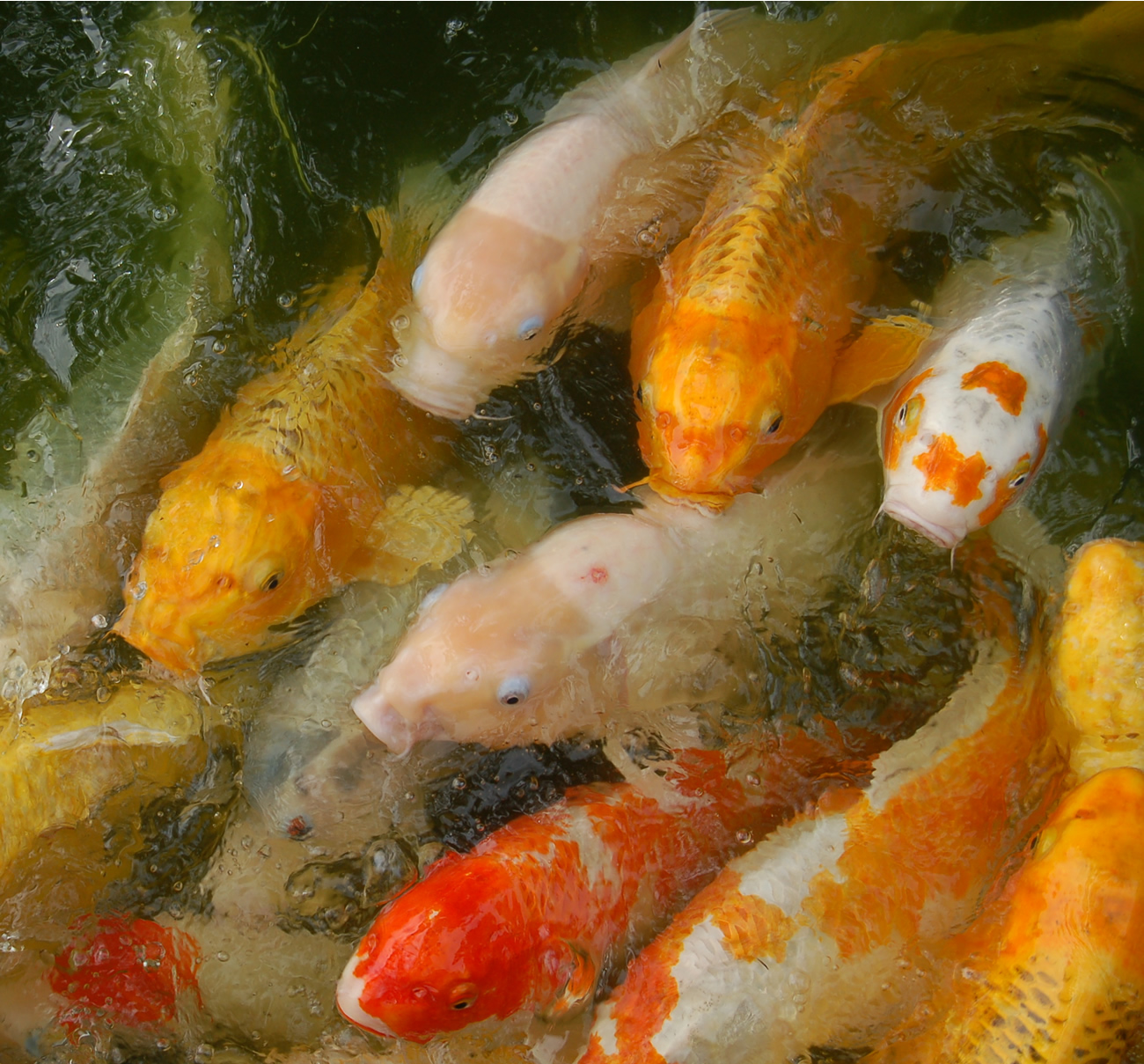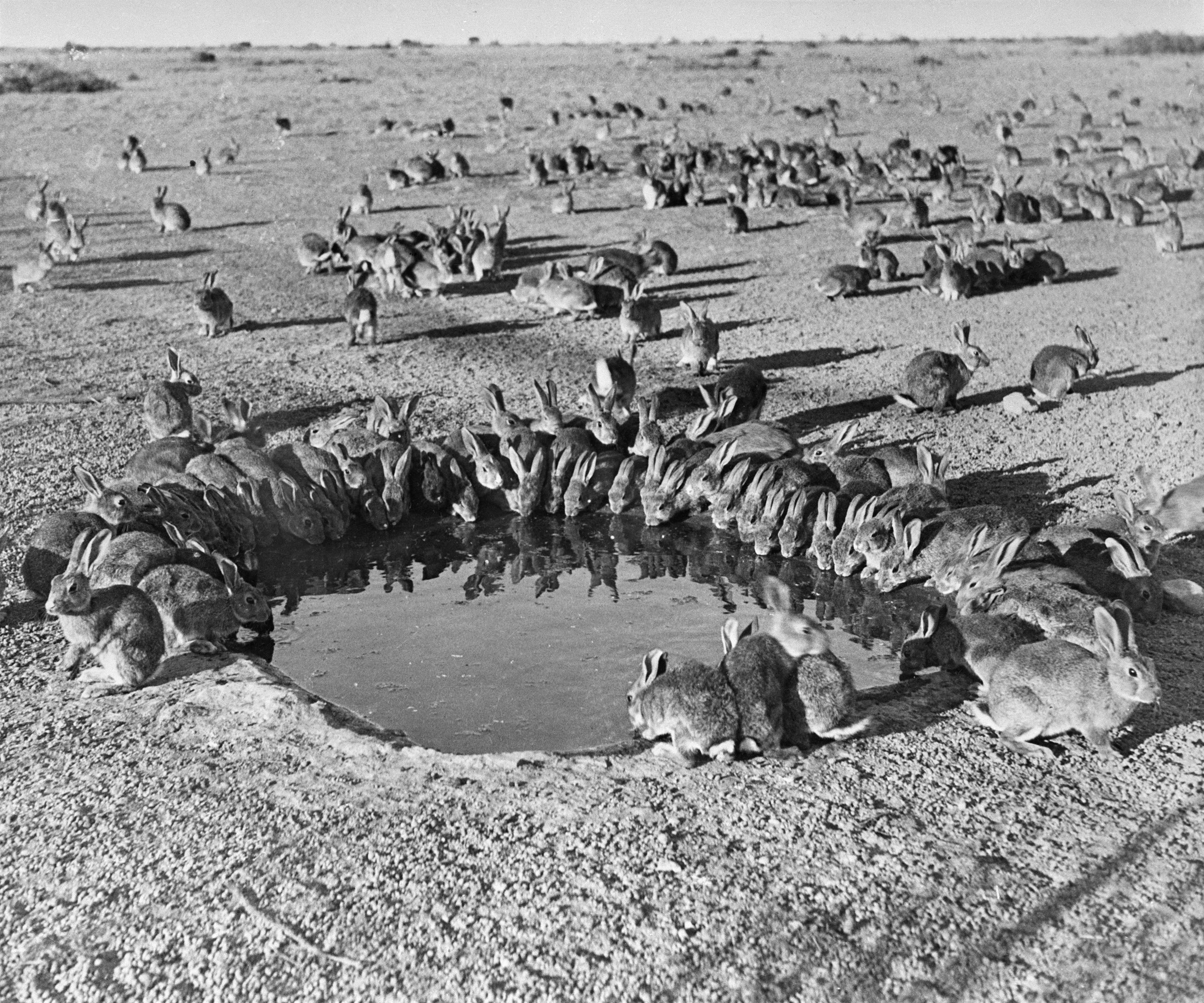‘Shhh. Be vewy vewy quiet, we’re wesearching viruses’.
If Elmer Fudd is the arch-enemy of Bugs Bunny, then it’s safe to say that we’re not only the arch-enemy of the European rabbit, but the fish known as the ‘rabbit of the waterways’ – the European carp.
We’re arming ourselves with viruses with the aim of keeping these two invasive species in check and to help protect Australia’s economy and environment. This strategy is called biological control (‘biocontrol’ for short) – using disease to tackle invasive pests.
The battle of the rabbit
This photo was taken under controlled conditions during myxoma virus trials on Wardang Island off South Australia in 1938. Photo: M W Mules/CSIRO.
The European rabbit is a serious threat to agriculture and biodiversity in Australia. Myxoma virus, released in 1950 and Rabbit Calicivirus Disease (RCD), released in 1996, have proven the only effective means to significantly reduce rabbit numbers. The benefits to the agricultural industries of these two biocontrol viruses are estimated at $70 billion.
The European rabbit was brought to Australia onboard the First Fleet in 1788, but only became a major pest in 1859 when 24 wild rabbits were released by a wealthy Victorian grazier keen on the sport of hunting, and, …well… they bred like wild rabbits! Soon millions of rabbits were competing with Australia’s livestock for feed and were damaging the environment and threatening our native animals.
Our predecessor, CSIR, conducted initial trials of myxomatosis that ultimately resulted in the release of the virus in 1950. It was the world’s first successful biocontrol program of a mammalian pest, taming a scourge that had threatened Australian agriculture and environment.
Lionel Bull, Chief of the CSIR Division of Animal Health and Nutition, releasing the first infected rabbits as part of the myxoma virus trial.
The initial release of myxoma virus led to a dramatic reduction of Australia’s rabbit population – killing 99.8 per cent of rabbits that caught the infection in some areas. Because the virus is spread by mosquitoes, it had its greatest impact in the highest rainfall areas but didn’t work as well in arid zones where mosquitoes can’t survive.
By the late 1950s, resistance to the myxoma virus was starting to build up in Australia’s rabbits. The virus became less effective and rabbit numbers increased, but not to pre-1950 levels.
RDC was first discovered in China in 1984 and soon after in other countries in Asia, Europe and in Mexico. The viral disease affects only European rabbits, and its discovery offshore alerted scientists to a potential new biocontrol for wild rabbits in Australia.
The introduction of calicivirus in Australia in 1996 again reduced rabbit numbers drastically, but it had greater impact in the arid zones and least impact in the higher rainfall areas. A few years ago we discovered that Australian rabbits in the higher rainfall areas actually carry a native calicivirus that may provide some immunity to the disease. This benign form of the virus is very similar, so we suspect it’s acting as an imperfect natural vaccine against the more virulent strain.
Calicivirus and myxomatosis are still having an impact, but over the years their effectiveness has declined. As a result, we’re currently researching different caliciviruses in Australian wild rabbits, and their interactions with RCD to help determine potential future implementations for rabbit biocontrol.
Curbing our carp numbers

A European Carp. Image: Dirk-Jan Kraan/Flickr
Carp is a pest associated with the poor health of our rivers and wetlands. The fish was first introduced to Australia more than 100 years ago and is now rampant in the Murray-Darling Basin.

Koi Carp. Image: sophietica/Flickr.
We’re currently investigating a disease called cyprinid herpesvirus-3, also known as koi herpesvirus (or KHV), as a potential new biocontrol agent to help eradicate carp from Australia. The virus first appeared in Israel in 1998, and spread rapidly throughout much of the world, although not to Australia or New Zealand. It causes high death rates in common carp and in the ornamental variety of carp known as koi carp. No other species of fish, including goldfish, are known to be affected by it.
We’re conducting our research within the world’s most sophisticated high containment facility within the CSIRO-Australian Animal Health Laboratory (AAHL), where we’re undertaking rigorous tests to determine the virus’ suitability for controlling carp.
We’ve identified that CyHV-3 does kill Australian carp, and it kills them quickly, and current research has shown that the virus doesn’t affect native Australian or any other introduced species of fish.
Over the next few years we’ll continue to test the susceptibility of other fish species to CyHV-3 and address questions regarding the safety of possible widespread distribution of the virus, both for humans and for other animal species.
For more information on biocontrol of invasive species, visit our biocontrol page.




30th May 2015 at 4:33 pm
well said buddy, rattling comfortably. It’s honor to
read your argument